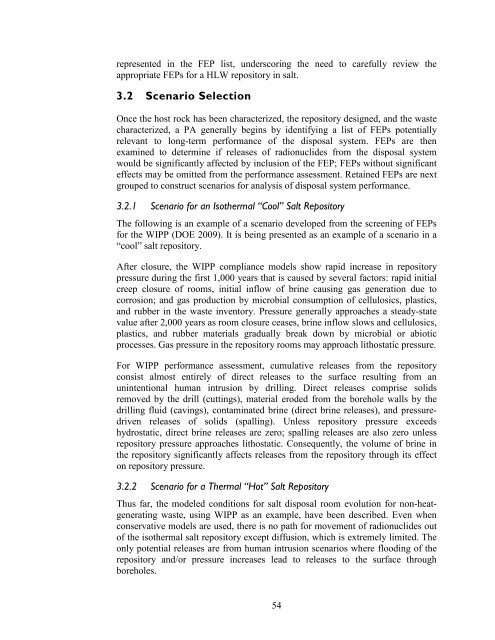Salt Disposal of Heat-Generating Nuclear Waste
Salt Disposal of Heat-Generating Nuclear Waste
Salt Disposal of Heat-Generating Nuclear Waste
Create successful ePaper yourself
Turn your PDF publications into a flip-book with our unique Google optimized e-Paper software.
epresented in the FEP list, underscoring the need to carefully review the<br />
appropriate FEPs for a HLW repository in salt.<br />
3.2 Scenario Selection<br />
Once the host rock has been characterized, the repository designed, and the waste<br />
characterized, a PA generally begins by identifying a list <strong>of</strong> FEPs potentially<br />
relevant to long-term performance <strong>of</strong> the disposal system. FEPs are then<br />
examined to determine if releases <strong>of</strong> radionuclides from the disposal system<br />
would be significantly affected by inclusion <strong>of</strong> the FEP; FEPs without significant<br />
effects may be omitted from the performance assessment. Retained FEPs are next<br />
grouped to construct scenarios for analysis <strong>of</strong> disposal system performance.<br />
3.2.1 Scenario for an Isothermal “Cool” <strong>Salt</strong> Repository<br />
The following is an example <strong>of</strong> a scenario developed from the screening <strong>of</strong> FEPs<br />
for the WIPP (DOE 2009). It is being presented as an example <strong>of</strong> a scenario in a<br />
“cool” salt repository.<br />
After closure, the WIPP compliance models show rapid increase in repository<br />
pressure during the first 1,000 years that is caused by several factors: rapid initial<br />
creep closure <strong>of</strong> rooms, initial inflow <strong>of</strong> brine causing gas generation due to<br />
corrosion; and gas production by microbial consumption <strong>of</strong> cellulosics, plastics,<br />
and rubber in the waste inventory. Pressure generally approaches a steady-state<br />
value after 2,000 years as room closure ceases, brine inflow slows and cellulosics,<br />
plastics, and rubber materials gradually break down by microbial or abiotic<br />
processes. Gas pressure in the repository rooms may approach lithostatic pressure.<br />
For WIPP performance assessment, cumulative releases from the repository<br />
consist almost entirely <strong>of</strong> direct releases to the surface resulting from an<br />
unintentional human intrusion by drilling. Direct releases comprise solids<br />
removed by the drill (cuttings), material eroded from the borehole walls by the<br />
drilling fluid (cavings), contaminated brine (direct brine releases), and pressuredriven<br />
releases <strong>of</strong> solids (spalling). Unless repository pressure exceeds<br />
hydrostatic, direct brine releases are zero; spalling releases are also zero unless<br />
repository pressure approaches lithostatic. Consequently, the volume <strong>of</strong> brine in<br />
the repository significantly affects releases from the repository through its effect<br />
on repository pressure.<br />
3.2.2 Scenario for a Thermal “Hot” <strong>Salt</strong> Repository<br />
Thus far, the modeled conditions for salt disposal room evolution for non-heatgenerating<br />
waste, using WIPP as an example, have been described. Even when<br />
conservative models are used, there is no path for movement <strong>of</strong> radionuclides out<br />
<strong>of</strong> the isothermal salt repository except diffusion, which is extremely limited. The<br />
only potential releases are from human intrusion scenarios where flooding <strong>of</strong> the<br />
repository and/or pressure increases lead to releases to the surface through<br />
boreholes.<br />
54
















